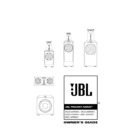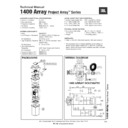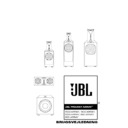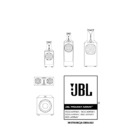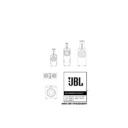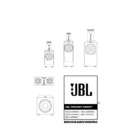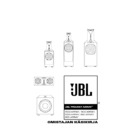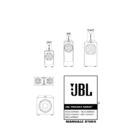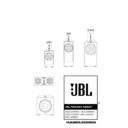JBL 1400 ARRAY (serv.man9) User Manual / Operation Manual ▷ View online
Power On
Plug your subwoofer’s AC cord
into a wall outlet. Do not use the
outlets on the back of the
receiver.
Plug your subwoofer’s AC cord
into a wall outlet. Do not use the
outlets on the back of the
receiver.
Initially set the Subwoofer Level
(Volume) Control ¢ to the
“min” position.
(Volume) Control ¢ to the
“min” position.
Turn on your sub by pressing
the Power Switch ª on the
rear panel.
the Power Switch ª on the
rear panel.
Auto On/Standby
With the Power Switch ª
in the “on” position, the Power
Indicator LED £ will remain
backlit in red or green to
indicate the On/Standby
mode of the subwoofer.
With the Power Switch ª
in the “on” position, the Power
Indicator LED £ will remain
backlit in red or green to
indicate the On/Standby
mode of the subwoofer.
RED = STANDBY (No signal
detected, Amp Off)
detected, Amp Off)
GREEN = ON (Signal detected,
Amp On)
Amp On)
The subwoofer will auto-
matically enter the Standby
mode after approximately 10
minutes when no signal is
detected from your system. The
subwoofer will then power ON
instantly when a signal is
detected. During periods of
normal use, the Power Switch
ª can be left on. You may turn
off the Power Switch ª for
extended periods of non-
operation, e.g., when you are
away on vacation.
matically enter the Standby
mode after approximately 10
minutes when no signal is
detected from your system. The
subwoofer will then power ON
instantly when a signal is
detected. During periods of
normal use, the Power Switch
ª can be left on. You may turn
off the Power Switch ª for
extended periods of non-
operation, e.g., when you are
away on vacation.
If the Auto Switch • is in the
“on” position, the subwoofer
will remain on.
“on” position, the subwoofer
will remain on.
Adjust Level
Turn on your entire audio
system and start a CD or movie
soundtrack at a moderate level.
Turn up the Subwoofer Level
(Volume) Control ¢ about
halfway. If no sound emanates
from the subwoofer, check the
AC-line cord and input cables.
Are the con-nectors on the
cables making proper contact?
Is the AC
plug connected to a “live”
receptacle? Has the Power
Switch ª been pressed to
the “on” position? Once you
have confirmed that the sub-
woofer is active, proceed by
playing a CD or movie. Use a
selection that has ample bass
information.
Turn on your entire audio
system and start a CD or movie
soundtrack at a moderate level.
Turn up the Subwoofer Level
(Volume) Control ¢ about
halfway. If no sound emanates
from the subwoofer, check the
AC-line cord and input cables.
Are the con-nectors on the
cables making proper contact?
Is the AC
plug connected to a “live”
receptacle? Has the Power
Switch ª been pressed to
the “on” position? Once you
have confirmed that the sub-
woofer is active, proceed by
playing a CD or movie. Use a
selection that has ample bass
information.
Set the overall volume control
of the preamplifier or stereo
to a comfortable level. Adjust
the Subwoofer Level (Volume)
Control ¢ until you obtain a
pleasing blend of bass. Bass
response should not over-
power the room but rather
should be adjusted so there is a
harmonious blend across the
entire musical range. Many
users have a tendency to set
the subwoofer volume too loud,
adhering to the belief
that a subwoofer is there to
produce lots of bass. This is not
entirely true. A subwoofer is
there to enhance bass,
extending the response of
the entire system so the bass
can be felt as well as heard.
However, overall balance
must be maintained or the
music will not sound natural. An
experienced listener will set the
volume of the sub-woofer so its
impact on bass response is
always there but never
obtrusive.
of the preamplifier or stereo
to a comfortable level. Adjust
the Subwoofer Level (Volume)
Control ¢ until you obtain a
pleasing blend of bass. Bass
response should not over-
power the room but rather
should be adjusted so there is a
harmonious blend across the
entire musical range. Many
users have a tendency to set
the subwoofer volume too loud,
adhering to the belief
that a subwoofer is there to
produce lots of bass. This is not
entirely true. A subwoofer is
there to enhance bass,
extending the response of
the entire system so the bass
can be felt as well as heard.
However, overall balance
must be maintained or the
music will not sound natural. An
experienced listener will set the
volume of the sub-woofer so its
impact on bass response is
always there but never
obtrusive.
Crossover Adjustments
NOTE: This control will have
no effect if the LP/LFE Selector
Switch ¶ is set to “LFE.” If you
have a Dolby Digital or DTS
processor/receiver, the
Crossover Frequency is set
by the processor/receiver.
Consult your owner’s manual to
learn how to view or change
this setting.
NOTE: This control will have
no effect if the LP/LFE Selector
Switch ¶ is set to “LFE.” If you
have a Dolby Digital or DTS
processor/receiver, the
Crossover Frequency is set
by the processor/receiver.
Consult your owner’s manual to
learn how to view or change
this setting.
The Crossover Adjustment
Control ∞ determines the
highest frequency at which the
subwoofer reproduces sounds.
If your main speakers can
comfortably reproduce some
low-frequency sounds, set this
control to a lower frequency
setting, between 50Hz and
100Hz. This will concentrate the
subwoofer’s efforts on
the ultradeep bass sounds
required by today’s films and
music. If you are using smaller
bookshelf speakers that do
not extend to the lower bass
frequencies, set the Crossover
Adjustment Control to a higher
setting, between 120Hz and
150Hz.
Control ∞ determines the
highest frequency at which the
subwoofer reproduces sounds.
If your main speakers can
comfortably reproduce some
low-frequency sounds, set this
control to a lower frequency
setting, between 50Hz and
100Hz. This will concentrate the
subwoofer’s efforts on
the ultradeep bass sounds
required by today’s films and
music. If you are using smaller
bookshelf speakers that do
not extend to the lower bass
frequencies, set the Crossover
Adjustment Control to a higher
setting, between 120Hz and
150Hz.
Phase Control
The Phase Switch § deter-
mines whether the subwoofer
speaker’s pistonlike action
moves in and out with the main
speakers (0˚) or opposite the
main speakers (180˚). Proper
phase adjustment depends
on several variables, such as
subwoofer placement and
listener position. Adjust the
Phase Switch to maximize bass
output at the listening position.
The Phase Switch § deter-
mines whether the subwoofer
speaker’s pistonlike action
moves in and out with the main
speakers (0˚) or opposite the
main speakers (180˚). Proper
phase adjustment depends
on several variables, such as
subwoofer placement and
listener position. Adjust the
Phase Switch to maximize bass
output at the listening position.
1500 ARRAY OPERATION
9
IMPORTANT: Make sure all
equipment is turned off before
making any connections.
equipment is turned off before
making any connections.
For speaker connections, use a
high-quality speaker wire with
polarity coding. The side of the
wire with a ridge or other
coding is usually considered
positive (+) polarity.
high-quality speaker wire with
polarity coding. The side of the
wire with a ridge or other
coding is usually considered
positive (+) polarity.
NOTE: If desired, consult
your local JBL dealer about
speaker wire and connection
options.
your local JBL dealer about
speaker wire and connection
options.
The speakers have coded
terminals that accept a variety
of wire connectors. The most
common connection is shown
in Figure 1.
terminals that accept a variety
of wire connectors. The most
common connection is shown
in Figure 1.
To ensure proper polarity,
connect each + terminal on the
back of the amplifier or receiver
to the respective + (red)
terminal on each speaker, as
shown in Figure 2. Connect the
– (black) terminals in a similar
way. See the owner’s guides
that were included
with your amplifier, receiver
and television to confirm
connection procedures.
connect each + terminal on the
back of the amplifier or receiver
to the respective + (red)
terminal on each speaker, as
shown in Figure 2. Connect the
– (black) terminals in a similar
way. See the owner’s guides
that were included
with your amplifier, receiver
and television to confirm
connection procedures.
IMPORTANT: Do not reverse
polarities (i.e., + to – or – to +)
when making connections.
Doing so will cause poor
imaging and diminished bass
response.
polarities (i.e., + to – or – to +)
when making connections.
Doing so will cause poor
imaging and diminished bass
response.
Figure 1
Figure 2
FINAL
ADJUSTMENTS
ADJUSTMENTS
Check the speakers for
playback, first by setting the
system volume control to a
minimum level, and then by
applying power to your audio
system. Play a favorite music or
video segment and increase the
system volume control to a
comfortable level.
playback, first by setting the
system volume control to a
minimum level, and then by
applying power to your audio
system. Play a favorite music or
video segment and increase the
system volume control to a
comfortable level.
NOTE: You should hear
balanced audio reproduction
across the entire frequency
spectrum. If not, check all
wiring connections or consult
the authorized JBL dealer from
whom you purchased the
system for more help.
balanced audio reproduction
across the entire frequency
spectrum. If not, check all
wiring connections or consult
the authorized JBL dealer from
whom you purchased the
system for more help.
Both the amount of bass you
hear and the stereo-image
quality will be affected by a
number of different factors,
including the room’s size and
shape, the construction
materials used to build the
room, the listener’s position
relative to the speakers, and
the position of the speakers in
the room.
hear and the stereo-image
quality will be affected by a
number of different factors,
including the room’s size and
shape, the construction
materials used to build the
room, the listener’s position
relative to the speakers, and
the position of the speakers in
the room.
Listen to a variety of music
selections and note the bass
level. If there is too much bass,
move the speakers away from
nearby walls. Conversely, if you
place the speakers closer to
the walls, there will be more
bass output.
selections and note the bass
level. If there is too much bass,
move the speakers away from
nearby walls. Conversely, if you
place the speakers closer to
the walls, there will be more
bass output.
Nearby reflecting surfaces can
adversely affect stereo-imaging
quality. If this happens, try
angling the speakers slightly
inward toward the listening
position until the optimum
effect is achieved.
adversely affect stereo-imaging
quality. If this happens, try
angling the speakers slightly
inward toward the listening
position until the optimum
effect is achieved.
CARE OF YOUR
SPEAKER SYSTEM
SPEAKER SYSTEM
Each Project Array enclosure
has a finish that does not
require any routine main-
tenance. When needed, use
a soft cloth to remove any
fingerprints or dust from
the enclosure or grille.
has a finish that does not
require any routine main-
tenance. When needed, use
a soft cloth to remove any
fingerprints or dust from
the enclosure or grille.
NOTE: Do not use any cleaning
products or polishes on the
cabinet or grille.
products or polishes on the
cabinet or grille.
WIRING THE SYSTEM
Separate and strip the ends of
the speaker wire (not supplied)
as shown. Speakers and
electronics terminals have
corresponding (+) and (–)
terminals. Most manufacturers
of speakers and electronics,
including JBL, use red to
denote the (+) terminal and
black for the (–) terminal.
the speaker wire (not supplied)
as shown. Speakers and
electronics terminals have
corresponding (+) and (–)
terminals. Most manufacturers
of speakers and electronics,
including JBL, use red to
denote the (+) terminal and
black for the (–) terminal.
The (+) lead of the speaker wire
is sometimes noted with
a stripe or other demarcation. It
is sometimes noted with
a stripe or other demarcation. It
is important to connect both
speakers identically: (+) on the
speaker to (+) on the amplifier
and (–) on the speaker to (–) on
the amplifier. Wiring “out of
phase” results in thin sound,
weak bass and a poor
stereo image.
speakers identically: (+) on the
speaker to (+) on the amplifier
and (–) on the speaker to (–) on
the amplifier. Wiring “out of
phase” results in thin sound,
weak bass and a poor
stereo image.
With the advent of multi-
channel surround sound
systems, connecting all of
the speakers in your system
with the correct polarity
channel surround sound
systems, connecting all of
the speakers in your system
with the correct polarity
remains equally important in
order to preserve the proper
ambience and directionality
of the program material.
order to preserve the proper
ambience and directionality
of the program material.
GENERAL CONNECTION INFORMATION
10
If there is no sound
from any of the
speakers:
from any of the
speakers:
• Check that receiver/amplifier
is on and a source is playing.
is on and a source is playing.
• Check all wires and con-
nections between receiver/
amplifier and speakers. Make
sure all wires are connected.
Make sure none of the speaker
wires are frayed, cut or
punctured.
nections between receiver/
amplifier and speakers. Make
sure all wires are connected.
Make sure none of the speaker
wires are frayed, cut or
punctured.
• Review proper operation of
your receiver/amplifier.
your receiver/amplifier.
If there is no sound
coming from one
speaker:
coming from one
speaker:
• Check the “Balance” control
on your receiver/amplifier.
on your receiver/amplifier.
• Check all wires and con-
nections between receiver/
amplifier and speakers. Make
sure all wires are connected.
Make sure none of the speaker
wires are frayed, cut or
punctured.
nections between receiver/
amplifier and speakers. Make
sure all wires are connected.
Make sure none of the speaker
wires are frayed, cut or
punctured.
• In Dolby Digital or DTS modes,
make sure that the
receiver/processor is con-
figured so that the speaker in
question is enabled.
make sure that the
receiver/processor is con-
figured so that the speaker in
question is enabled.
If there is no sound
from the center
speaker:
from the center
speaker:
• Check all wires and connec-
tions between the receiver/
amplifier and speaker. Make
sure all wires are connected.
Make sure none of the speaker
wires are frayed, cut or
punctured.
tions between the receiver/
amplifier and speaker. Make
sure all wires are connected.
Make sure none of the speaker
wires are frayed, cut or
punctured.
• If your receiver/processor is
set in Dolby Pro Logic
set in Dolby Pro Logic
®
mode,
make sure the center speaker
is not in phantom mode.
is not in phantom mode.
• If your receiver/processor
is set in Dolby Digital or DTS
mode, make sure the receiver/
processor is configured so that
the center speaker is enabled.
is set in Dolby Digital or DTS
mode, make sure the receiver/
processor is configured so that
the center speaker is enabled.
If the system plays
at low volumes but
shuts off as volume
is increased:
at low volumes but
shuts off as volume
is increased:
• Check all wires and con-
nections between receiver/
amplifier and speakers. Make
sure all wires are connected.
Make sure none of the speaker
wires are frayed, cut or
punctured.
nections between receiver/
amplifier and speakers. Make
sure all wires are connected.
Make sure none of the speaker
wires are frayed, cut or
punctured.
• If more than one pair of main
speakers is being used, check
the minimum impedance
requirements of your
receiver/amplifier.
speakers is being used, check
the minimum impedance
requirements of your
receiver/amplifier.
If there is low (or no)
bass output (1500
Array):
bass output (1500
Array):
• Make sure the connections to
the left and right “Speaker
Inputs” have the correct
polarity (+ and –).
the left and right “Speaker
Inputs” have the correct
polarity (+ and –).
• Make sure the subwoofer
is plugged into an active elec-
trical outlet.
is plugged into an active elec-
trical outlet.
• Make sure the Power switch
ª is on.
ª is on.
• In Dolby Digital or DTS modes,
make sure your
receiver/processor is con-
figured so that the subwoofer
and LFE output are enabled.
make sure your
receiver/processor is con-
figured so that the subwoofer
and LFE output are enabled.
• Adjust the LF Level control ¢.
If there is no sound
from the surround
speakers:
from the surround
speakers:
• Check all wires and con-
nections between receiver/
amplifier and speakers. Make
sure all wires are connected.
Make sure none of the speaker
wires are frayed, cut or
punctured.
nections between receiver/
amplifier and speakers. Make
sure all wires are connected.
Make sure none of the speaker
wires are frayed, cut or
punctured.
• Review proper operation of
your receiver/amplifier and its
surround sound features.
your receiver/amplifier and its
surround sound features.
• Make sure the movie or TV
show you are watching is
recorded in a surround sound
mode. If it is not, check to see
whether your receiver/amplifier
has other surround modes you
may use.
show you are watching is
recorded in a surround sound
mode. If it is not, check to see
whether your receiver/amplifier
has other surround modes you
may use.
• In Dolby Digital or DTS modes,
make sure your receiver/
processor is configured so that
the surround speakers are
enabled.
make sure your receiver/
processor is configured so that
the surround speakers are
enabled.
• Review the operation of your
DVD player and the jacket of
your DVD to make sure that the
DVD features the desired Dolby
Digital or DTS mode, and that
you have properly selected that
mode using both the DVD
player’s menu and the DVD
disc’s menu.
DVD player and the jacket of
your DVD to make sure that the
DVD features the desired Dolby
Digital or DTS mode, and that
you have properly selected that
mode using both the DVD
player’s menu and the DVD
disc’s menu.
TROUBLESHOOTING
11
SPECIFICATIONS
All features and specifications are subject to change without notice.
®
PRO SOUND COMES HOME
™
JBL Consumer Products, 250 Crossways Park Drive, Woodbury, NY 11797 USA
2, route de Tours, 72500 Château du Loir, France
516.255.4JBL (4525) (USA only) www.jbl.com
Part No.361041-002
1400 ARRAY
1000 ARRAY
800 ARRAY
880 ARRAY
1500 ARRAY
3-Way, 14" (350mm)
3-Way, 10" (250mm)
3-Way, 8" (200mm)
3-Way, Dual 8"
15" (380mm)1000-Watt
Floorstanding
Floorstanding
Bookshelf
(200mm) Center
Front-Firing Sub
Ultrahigh-Frequency
045Ti: 1" Pure-titanium
045Ti: 1" Pure-titanium
045Ti: 1" Pure-titanium
045Ti: 1" Pure-titanium
N/A
Transducer
compression driver
compression driver
compression driver
compression driver
with aluminum
with aluminum
with aluminum
with aluminum
edge-wound voice coil
edge-wound voice coil
edge-wound voice coil
edge-wound voice coil
and 2" neodymium
and 2" neodymium
and 2" neodymium
and 2" neodymium
motor assembly, mounted
motor assembly, mounted
motor assembly, mounted
motor assembly, mounted
in a SonoGlass
™
constant-
in a SonoGlass
™
constant-
in a SonoGlass
™
constant-
in a SonoGlass
™
constant-
directivity horn
directivity horn
directivity horn
directivity horn
High-Frequency
435AL-1: 3" Aquaplas-treated
175Nd-3: 1-3/4" Aquaplas-treated
175Nd-3: 1-3/4" Aquaplas-treated
435AL: 3" Aquaplas-treated
N/A
Transducer
aluminum-dome compression
aluminum-dome compression
aluminum-dome compression aluminum-dome
compression
driver with aluminum
driver with aluminum
driver with aluminum
driver with aluminum
edge-wound voice coil and
edge-wound voice coil and
edge-wound voice coil and
edge-wound voice coil and
neodymium motor assembly,
neodymium motor assembly,
neodymium motor assembly,
neodymium motor assembly,
mounted in a vertical SonoGlass
™
mounted in a vertical SonoGlass
™
mounted in a vertical SonoGlass
™
mounted in a vertical SonoGlass
™
constant-directivity horn
constant-directivity horn
constant-directivity horn
constant-directivity horn
Low-Frequency
LE14H-3: 14" Aquaplas-treated
Array 10: 10" Polymer-treated
Array 8: 8" Polymer-treated
Dual Array 8C: 8" Polymer-treated
W1500H: 15" Pulp-cone
Transducer
pulp-cone driver with rubber
pulp-cone driver with rubber
pulp-cone driver with rubber
pulp-cone drivers with 1-1/2"
driver with rubber surround
surround and massive ferrite
surround, 1-1/2" copper
surround, 1-1/2" copper
voice coils wound on
and massive ferrite motor
motor assembly with 4" copper
voice coil and ferrite
voice coil and ferrite
an aluminum former and ferrite
assembly with 4" copper edge-
edge-wound voice coil, mounted
motor assembly, mounted in
motor assembly, mounted in
motor assemblies, mounted on
wound voice coil, mounted
in a trapezoidal enclosure
a trapezoidal enclosure
a trapezoidal enclosure
angled baffles in independent
in a trapezoidal enclosure
trapezoidal enclosures
Sensitivity (2.83V/1m)
89dB
89dB
88dB
90dB
N/A
Frequency
32Hz – 40kHz
35Hz – 40kHz
55Hz – 40kHz
70Hz – 40kHz
25Hz – 400Hz, variable
Response (–3dB)
Recommended
10 – 300 Watts
10 – 200 Watts
10 – 200 Watts
10 – 200 Watts
N/A
Amplifier Power Range
Crossover Frequencies
750Hz, 8kHz
900Hz, 8kHz
1000Hz, 8kHz
1000Hz, 8kHz
40Hz – 140Hz HP
Nominal Impedance
8 Ohms
8 Ohms
8 Ohms
8 Ohms
N/A
Port
4" Flared
3-3/8" Flared
2" Flared
N/A
4" Flared
Dimensions
46-1/2" x 15-1/2" x 19"
43-1/2" x 12-1/4" x 17"
29-1/4" x 10-3/4" x 14"
12-1/4" x 28-3/4" x 11"
23" x 19-1/2" x 19"
(H x W x D)
(1181mm x 394mm x 483mm)
(1105mm x 311mm x 432mm)
(743mm x 273mm x 356mm)
(311mm x 730mm x 279mm)
(584mm x 495mm x 483mm)
21" (533mm)
Deep with grille
Weight (each)
52kg (115 lb)
32kg (70 lb)
18kg (40 lb)
21kg (46 lb)
57kg (125 lb)
JBL and Harman International are trademarks of Harman International Industries,
Incorporated, registered in the United States and/or other countries.
Project Array, Pro Sound Comes Home and SonoGlass are trademarks of
Harman International Industries, Incorporated.
Dolby and Pro Logic are trademarks of Dolby Laboratories.
DTS is a registered trademark of DTS, Inc.
Declaration of Conformity
We, Harman Consumer Group International
2, route de Tours
72500 Château du Loir
France
72500 Château du Loir
France
declare in own responsibility that the products
described in this owner’s manual are in compliance
with technical standards:
EN 61000-6-3:2001
EN 61000-6-1:2001
described in this owner’s manual are in compliance
with technical standards:
EN 61000-6-3:2001
EN 61000-6-1:2001
Laurent Rault
Harman Consumer Group International
Château du Loir, France 10/05
Declaration of Conformity
We, Harman Consumer Group International
2, route de Tours
72500 Château du Loir
France
72500 Château du Loir
France
declare in own responsibility that the product
described in this owner’s manual is in compliance with
technical standards:
EN 55013:2001+A1:2003
EN 55020:2002+A1:2003
EN 61000-3-2:2000
EN 61000-3-3:1995+A1:2001
EN 60065:2002
described in this owner’s manual is in compliance with
technical standards:
EN 55013:2001+A1:2003
EN 55020:2002+A1:2003
EN 61000-3-2:2000
EN 61000-3-3:1995+A1:2001
EN 60065:2002
Laurent Rault
Harman Consumer Group International
Château du Loir, France 10/05
1400 Array, 1000 Array, 800 Array, 880 Array
1500 Array (230V only)

